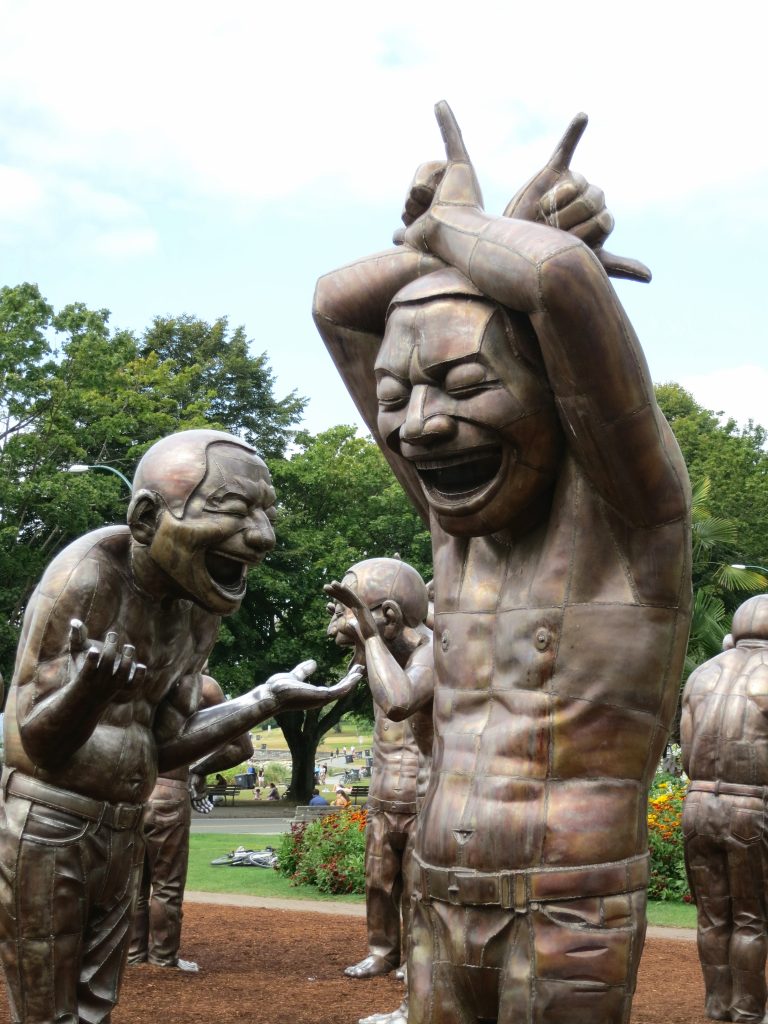4.1 Emotional Life

Learning Outcomes
By the end of this chapter, you’ll be able to:
- Define and describe feeling rules and emotion management
Introduction
The study of micro-level interaction has been a rich source of insight in sociology. The idea that people’s emotions, for example, have a social component might not be all that surprising at first because often individuals are subject to having “emotional reactions” to other people, positive or negative. The other person, or the social situation itself, brings on an emotion that otherwise would not arise.
However, sociological research has shown that emotions also can have a systematic, socially structured quality which is not immediately apparent. Studies of face-to-face conversations show that the outward signs of emotion like smiling or laughing are not equally distributed. For example, the predisposition to show emotion by laughing in a conversation is structured by differences in gender, status, role, and norm. Robert Provine (1996) studied 1200 two-person conversations, observed discretely in public places like shopping malls. He discovered that when a woman was speaking, and a man was listening the woman laughed more than twice as much as the man. Similarly, when a man was speaking and a woman listening, she was still more likely to laugh than him. “Female speakers laugh 127 per cent more than their male audience. In contrast, male speakers laugh about 7 per cent less than their female audience” (Provine, 1996). Provine suggests that this shows that males lead in producing humour while females lead in laughing at humour, but it might also show a pattern of social deference reflecting the unequal social status of men and women.
How a culture laughs when it laughs and at what it laughs also varies through history. Jokes often hone in on what people are most anxious about as a culture. The Roman Classicist Mary Beard (2014) argues that while it is very difficult to go from the recorded literature to a confident appraisal of what laughter and its place in social life in ancient Rome was like, the nature of the jokes the Romans told reveals an anxiety about the ability to demonstrate identity unique to Roman culture. Many jokes had the common theme of “how do I know that I am me?” and “how can I prove to others that I am me?”
For example, “two friends meet in the street and one says to the other, ‘I heard that you were dead,’ and the other says, ‘I’m not dead, you can see me, here I am,’ to which the first replies, ‘But the person who told me you were dead is much more reliable than you are.’”
This typical Roman joke refers to a cultural context in which demonstrating status was extremely important but official proofs of identity like passports or ID cards were minimal (Beard 2014).
What is perhaps even more significant regarding the unique emotional life of the Romans is Beard’s claim that the Romans did not smile, or more accurately, that the expression contemporary people experience as smiling played no significant role in Roman facial communication. The Romans might have turned their mouths up at the corners, but the smile was not a significant gesture in their social interaction. There are no accounts of smiling in Roman literature. The Roman words that are sometimes translated into English as smile are ridere and subridere which mean “laugh” and “little laugh” respectively; no word for smile exists. Beard concludes that the culture of the smile and the expectation of cheerfulness that figure so prominently in modern emotional life (smiling when meeting someone, smiling to show pleasure, smiling in photographs, etc.) did not exist in Roman life. Medieval scholars suggest that the culture of the smile was not invented until the Middle Ages (Beard 2014).
Raymond Williams referred to structures of feeling to capture large scale, societal shifts in people’s feelings or emotional responses towards things. These are “characteristic elements of impulse, restraint, and tone; specifically affective elements of consciousness and relationships” (Williams, 1977). They are structures in the sense that they are composed of sets of interlocking emotional components that go together, but in the moment, they are also fluid and in process; difficult to define until after the fact. Research into the transition from premodern to modern European family life, for example, indicates several changes in societal structures of feeling in the 18th and 19th centuries: the growing importance of romantic love in mate selection, of maternal love and commitment in child-rearing, of deep grief for the loss of a child, and of anger constraint and temper management within the family (Stearns, 2014). The emotional environment of family life became “warmer” as capitalist economic life became “colder” and more calculated. New humanitarian feelings of connection with the suffering of distant others also emerged, which fueled the 19th century movements for the abolition of slavery. Similarly, the emergence of nostalgia was a new structure of feeling at this time. People formulated emotional responses to the losses and displacements brought about by new patterns of migration, travel, urbanization, and industrialization. Structures of feeling are a fluid component of collective life, yet they lead to large scale social change. They impact how individuals feel and what they feel about.
Prominent sociologists have argued that the structure of feeling of contemporary society is defined by an emotional state of anxiety (Giddens, 1990; Beck, 1992). Anxiety is a future-oriented emotion aroused by uncertainty, unpredictability, and lack of control. In a global context of existential crises including climate change, virus pandemics, economic crises, the ability to collectively understand and manage risk is compromised. Public trust in the numerous technical and expert systems which govern global life outside of or beyond individual control, is also shaken when these are revealed to be precarious. People become skeptical about scientific knowledge and public authorities, but because responsibilities for managing and understanding risks are increasingly downloaded onto individuals, the structure of feeling that emerges is a permanent, pervasive, low intensity anxiety. In moments of crisis, this drives the characteristic divide in contemporary Canadian emotional life between the demands for more caring institutional or collective responses and outbursts of violence and aggression towards authorities.
Feeling Rules
In fact, emotional life follows detailed cultural scripts and feeling rules. Feeling rules are a set of socially shared guidelines that direct how people want to try to feel and not to feel emotions according to given situations (Hochschild, 1979). People are obliged to systematically manage their emotions in response to different social situations.
For example, we often speak of “having the right” to feel angry at someone. Or we say we “should feel more grateful” to a benefactor. We chide ourselves that a friend’s misfortune, a relative’s death, “should have hit us harder,” or that another’s good luck, or our own, should have inspired more joy. We know feeling rules, too, from how others react to what they infer from our emotive display. Another may say to us, “You shouldn’t feel so guilty; it wasn’t your fault,” or “You don’t have a right to feel jealous, given our agreement” (Hochschild, 1979).
As Hochschild argues, the fact that people are even able to distance themselves enough from their feelings to recognize that something like a set of feeling rules may or may not apply in certain situations is a product of the modern “ironic” posture towards the self, quite foreign to traditional cultures.

Making Connections: Sociology in the Real World: Do Funeral Selfies Violate Deeply Held Feeling Rules?
An example of issue that revolves around feeling rules is the controversy that emerged over people posting selfies at funerals. A headline in the Huffington Post read, “Funeral Selfies Are The Latest Evidence Apocalypse Can’t Come Soon Enough” (Huffington Post, 2013). Taking selfies at funerals is seen to violate deeply held views about the solemnity and emotional tenor of funerals and the etiquette of mourning.
A commentator on an article that defended funeral selfies stated the problem clearly:
But I can’t comprehend WHY you would be taking pictures of yourself if you’re so deep into the grieving process. It does not compute. When my mother died six years ago … I didn’t decide to whip out my phone and take photos of myself in my cute outfit or pretty makeup …. I didn’t even think about that stuff. I was too busy grieving the loss of someone that I loved. I just don’t understand how taking a selfie has anything to do with the grieving process. It’s just wildly inappropriate imo [in my opinion]. It bugs me that they don’t think of this before they post the damn pic or don’t care (Doughty, 2013).
For this commentator, it is not just that selfies are seen as frivolous, but that the people taking them do not know how to feel the appropriate feelings. She sees this as a character defect.
The defender of funeral selfies, a mortician herself, makes a similar argument but from the other side of the issue. Breaking the feeling rules of funerals is not good etiquette but reflects “our tragic disengagement with the reality of death” rather than a personal defect. “Modern death practices in the West, created by the funeral industry, have given teenagers diddly squat to do when someone dies” and therefore their feelings have no support in collective ritual (Doughty, 2013).
Emotional Management
Emotions are therefore subject to more or less conscious practices of emotion management, the way individuals work on producing or inhibiting feelings according to the social expectations of different situations. They are not as natural, spontaneous, or involuntary as popularly assumed. Moreover, this intimate and personal component of life is subject to macro-level processes like commodification. In post-industrial societies, services—nursing and care professions, flight attendants, call center employees, waiters, sales clerks, teachers, community policing officers, therapists, etc.—increasingly require expertise in the use of emotional labour. Sociologists speak of emotional labour “when deep gestures of exchange enter the market sector and are bought and sold as an aspect of labour power” (Hochschild, 1979). Managing emotion according to meticulous protocols becomes part of the job description because emotional tonality is part of the commodity being sold.
Media Attributions
- A-Maze-ing Laughter © Ruth Hartnup is licensed under a CC BY (Attribution) license
- Funeral Service © MudflapDC is licensed under a CC BY-NC-ND (Attribution NonCommercial NoDerivatives) license

